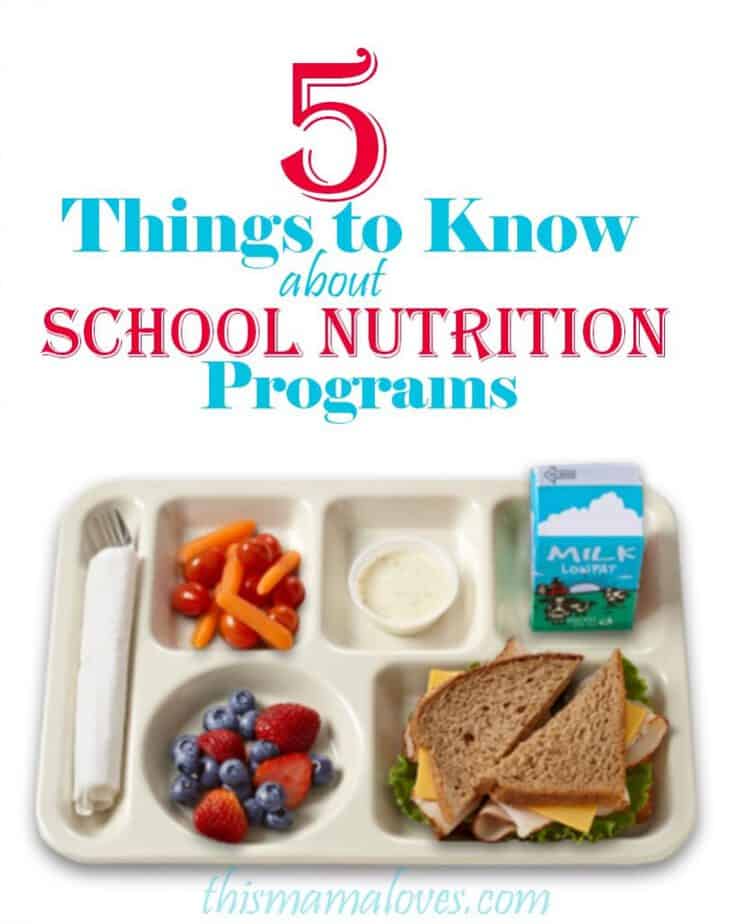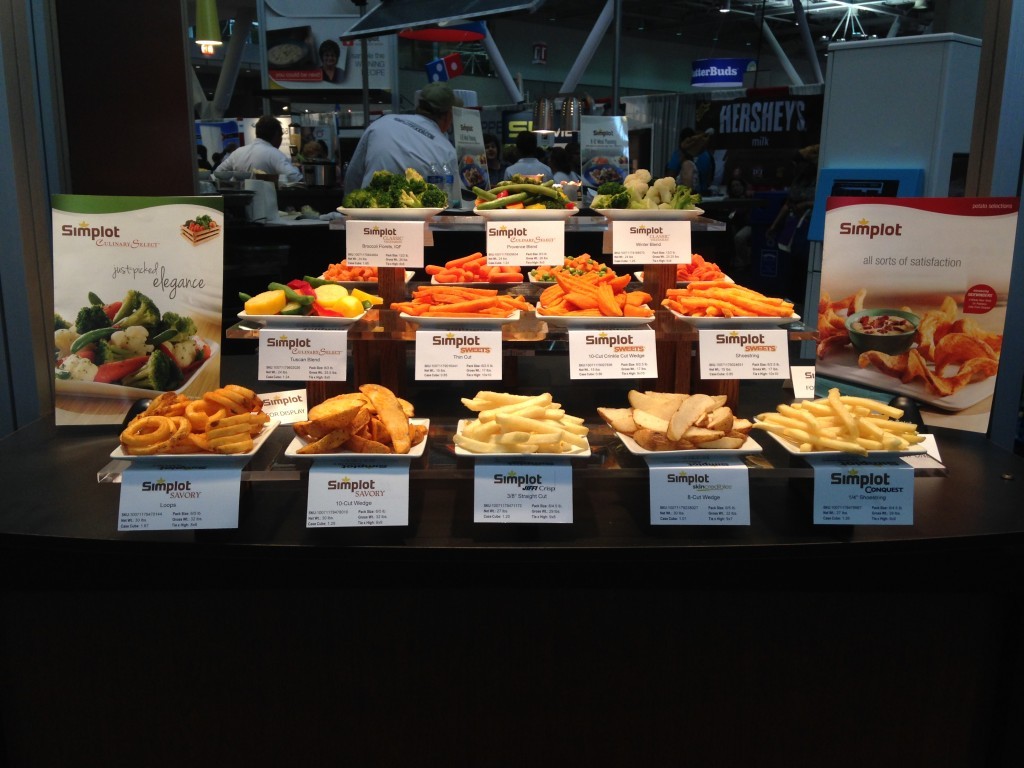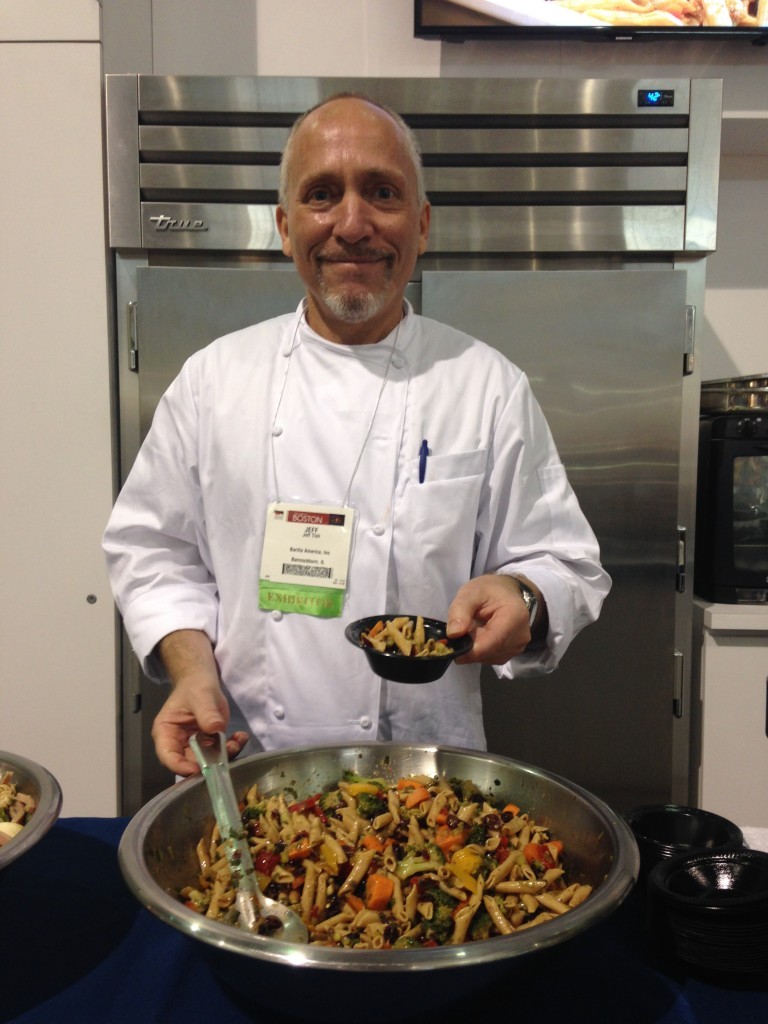Last week I was invited to attend the School Nutrition Association‘s National Conference for a day. Having three kids in school full time this year for the first time means I’ll have three kids who may buy lunch at school. I like to be informed about what my family is eating.
Attending the conference was a great experience for me. Not only did I get to meet two long time blog pals in person for the first time but I also learned oh so very much about school nutrition programs in general. I really kind of had no idea just how uninformed I truly was before I went to this conference!
Five Things About School Nutrition Programs
1. This is not your mama’s school lunch.
Or even my school lunch. Times have changed. Menus have changed.
I have vivid memories of some of the stuff that was served on our plates in school Especially vegetables! They didn’t, not once, look anything like these!
2. What you see on school menus is not what you find at the grocery store.
This was a big one for me. Seeing toaster pastries on the menu for breakfast or chicken nuggets, for example, for lunch often gave me pause. But ANYTHING served in schools has to meet standards- so maybe that brand of chicken nuggets you use at home is the same brand they serve at your kids’ school, but the breading used is whole grain… the toaster pastries have to be within a set number of calories, grains, salt content, etc…the pasta served isn’t the same as you have in your pantry.
Even cereals served for breakfast are lower in calories, lower in sugar, lower in fat content, and made with whole grains. So while we adults may not love the idea that Fruit Loops are served for breakfast, it makes (most of) the kids happy, and we can know that the kids having that for breakfast are not having the same sugary cereals that we see on supermarket shelves.
3. There are federal guidelines for school nutrition programs.
This probably should be higher in the list, but this isn’t a list based on importance. The USDA has requirements and guidelines for foods served in schools. Period. The items on the school menus that come home (or pop up in your email) ALL have to meet those guidelines.
The Healthy, Hunger-Free Kids Act of 2010 (HHFKA) required the U.S. Department of Agriculture (USDA) to update these nutrition standards for the first time in 15 years. The new regulations, effective July 1, 2012, require cafeterias to offer more fruit, vegetables and whole grains and limit sodium, calories and unhealthy fat in every school meal.
To ensure all foods and beverages sold in school during the school day are healthy choices, HHFKA also required USDA to create nutrition standards for foods and beverages sold in competition to reimbursable meals. These “competitive foods” are sold in vending machines, snack bars and a la carte lines. In June 2013, USDA issued the “Smart Snacks in School” interim final rule establishing these standards, which go into effect July 1, 2014.
4. When a brand you recognize (ie Pizza Hut, Dominos) is listed on your school lunch menu, the foods are made for school programs and are not the same as what you get in the restaurant and/or store.
I honestly thought when seeing Dominos Pizza or Pizza Hut on the kids’ lunch menus that perhaps the school had an agreement and it was a way to save costs! But, as it turns out, both brands, as well as others, have their school nutrition versions of products. Pizza is a popular food in my house (as it is in many) and is always a day that the kids, especially my son, want to buy lunch when it’s up on the menu. It’s a lot easier to agree to him having pizza for lunch once a week knowing that the ingredients meet the USDA requirements and are made with whole grains, lower sodium and fat levels.
5. Most school nutrition programs aren’t funded by the board of education. Most offer a la carte items to offset costs. Even the ice cream bars, for example, have to meet FDA guidelines for school nutrition.
Starting this year, my oldest had a la carte items available for purchase every day. You can imagine my surprise to hear that she had ice cream available for purchase every day. Actually, the first time I spoke with the PR team from the School Nutrition Association about attending this conference, this was one of the first things I said to them. I realize I’m in a position most aren’t, and was able to attend a conference for the folks who work with school nutrition in so many aspects.
I was also brought around to some of the booths set up in the expo hall by a Nutrition professional from Connecticut (where I live, if you don’t know) who knew of my concerns and took the time to plan visits to brands and companies that she knows meet the standards we have here in CT…including Blue Bunny ice cream, which she knows to meet our state standards. While I’m still not enamored with the idea that kids have ice cream available for purchase daily, I do understand more now that this is to help with the costs of running school lunch programs and a la carte items are one way to help offest those costs. I am MUCH more comfortable with the idea that those ice creams available to the kids for purchase have to meet the same standards that anything else in a school cafeteria , which means they cannot be over a certain number of calories, fat content or sodium content. I (wrongly) assumed, as many other parents have when I have spoken with them, that those ice cream products offered to the kids in the a la carte line were the same as what we could see in the grocery store freezer cases. They aren’t. The folks at Blue Bunny and my guide, Cindy (thank you Cindy!), were really great about showing me just what met our standards and what the calorie counts must be for snacks, serving sizes, sodium content, etc.
Be sure to like Tray Talk for Parents!



Christina Aleman says
Schools can try selling foods that are rich in vitamis, they can try MORINGGA BREAD PIZZA for example. its healthy and nutritious too unlike our regular pizza.
Rachel. Stout says
I work for a public school in Arkansas and we are all governed by the usda on what we can serve. No extra sugar, low sodium, no artificial sweettners or filers. All whole grains salads offered everyday. I don’t even remember having lunch like these. There is a lot parents and educators a like do not understand about school lunches and there programs.
Heather says
The requirements apply only if the school is on the National School Lunch Program(NSLP) and receives federal funds. If they are not, they can serve whatever sells and/or whatever the local school board would like them to serve. Many schools across the country have opted out of NSLP because the federal funding wasn’t increased to cover the increase in costs to purchase the foods to meet the new requirements. The new requirements created an increase cost of between .25-.35 cents per meal. Schools have also found they have had a reduction in participation in student lunches because of the new meal requirements. Locally, you can read an article from the Chicago Tribune about District 214 giving up $900,000 of federal funding because they only had 17% student lunch participation. The new requirements help to expose the k-8 grade age group to fresh fruits and vegetables and provides a foundation for healthy eating patterns. True healthy eating habits should be established at home by the parents but sadly that isn’t always the case. I applaud those parents that take interest in exposing their children to a variety of foods and providing healthy eating guidelines in their home.
Jan says
I am a Food Service Manager at a school in Virginia. My entire staff and I eat the food we prepare for lunch every day…it’s fresh and it’s delicious! We love our food and our students!
Kenda says
I still think there’s a lot of work that can be done, not to just make the lunches healthier, but make them more accessible to the children who need them. There’s still a lot to be done on the health factor too, but too many children are going hungry because while they get a free or reduced cost lunch, it’s pretty slim.
Kasja Larson says
There is always work to be done, no argument there and I know school food professionals are hard at work! However for kids that are on free & reduced programs are able to get all 5 components (Meat, Grain, Fruit, Vegetable and Milk) offered in the school meal by law, making a complete meal. Often times they are allowed as well to go back for seconds on Fruits and Vegetables if they are still hungry. I am the dietitian for a large district in Colorado and I know our biggest concern is feeding kids enough nutritious food!
Liz Mays says
When my kids were in school, the pizza from restaurants deliveries were NOT better for you than anyone else. It’s good to know things have changed in that regard. (Mind you, I still let them have hot lunch on those days, cuz dude, it’s pizza.)
Brett says
Right. Pizza=yum.
Amber Edwards says
I was actually very surprised at some of what i read. I was getting really irritated at some of the meals my kids were eating at the school the last year; lots of big brand name cereals and foods I normally wouldn’t approve of. But after this, knowing that they would have a different version of the ingredients to meet the standards, I’m not quite as upset.
Brett says
That’s exactly how I felt, Amber. I was in the dark about things. Many states, including Connecticut, also exceed some of the standards/requirements so your state may as well. It’s a lot easier to “swallow” that my kids are having ice cream available daily when it’s under 200 calories with a lower fat content, or that the Fruit Loops offered are reduced sugar and whole grains for sure.
Angie | Big Bear's Wife says
Love these options! When I went to school you have a choice between pizza and chicken sandwiches.
Marina @ Mommy Snippets says
Good to know! I had no idea about any of these!
Rosey says
How interesting! I didn’t know big brands like Pizza Hut or Domino’s partnered with schools for lunch. That’s a good thing to know about the separate foods they serve when they do (have such partnerships).
Elizabeth @ Being MVP says
Wow good to know. My daughter enters kindergarten next year!
Jeanine @ sixtimemommy.com says
Great facts! It’s so important to have the kids getting good nutritious lunches for school! Our school doesn’t provide a lunch we do so I always make sure it’s up to par!
Shell says
I had no idea! Everyone always talks about how unhealthy school lunches are, but it looks like that’s not so much the case!
Carly from The Puzzled Palate says
Thank you for catching up to speed on school lunches. My daughter has a gluten-allergy- so I plan on packing her lunch.
Chrysa says
I did not know that brands in schools are of different nutrients. That is good to know. At this point it is good to pack a lunch then you know what your kids are getting for lunch.
Sandy says
I sure hope they’re not replacing those “unhealthy ” fats and sugars with even less healthy artificial fats and sweeteners. I’d like to see an all natural, portion controlled, meal plan for our children.
Brett says
Me too, Sandy. Although, of course, a LOT of it all boils down to budget.
Lindsey @ Redhead Baby Mama says
I work at a private school, and the lunch there is to DIE for. Our public schools aren’t so lucky.